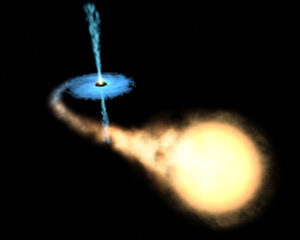I work on high energy astrophysics . This includes transient emission from compact objects such as Gamma-ray bursts (GRB’s), X-ray binaries (microquasars), Active Galactic Nuclei (AGN’s) and the recently discovered tidal disruption events (TDE’s). I am also interested in the origin of high energy cosmic rays.
The science I am involved in includes a wide range of physical disciplines, such as astrophysical plasmas, nuclear processes, radiative processes, relativistic gas dynamics, particle acceleration, and (relativistic) magneto-hydrodynamics. My research is both theoretical (analytical and numerical), and phenomenological.
In recent years, I devote a lot of efforts to the general-relativistic, radiative, magneto-hydrodynamic (GR-R-MHD) code cuHARM
Gamma-ray bursts 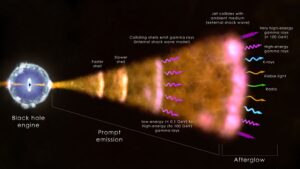
As their name implies, gamma-ray bursts (GRBs) are short, intensive bursts, originally detected in the gamma-ray part of the spectrum, hence their name. Being of cosmological origin, these are the brightest explosions in the universe, releasing as much as 10^53 erg/s in the form of gamma-rays. As such, they fascinate the imagination of many, since the 1990’s.
I have been working on this field since my Ph.D. time, for over 20 years now. Here is a link to a short review I wrote at the end of 2024.
While I carried many works on the subject, I highlight here one which, to my opinion, have the potential of revolutionizing this field. By analyzing the early afterglow data, we recently concluded that many GRB jets may be much slower than previously thought, with Lorentz factor of ‘only’ a few tens, rather than few hundreds, as previously thought.

The paper, led by my Postdoc Husne Dereli-Begue, was published in Nature Communication.
X-ray emitting binaries
Apparently, about 60% of the stars in our galaxy are in fact binary stars- two stars that rotate around each other. At a certain point, one of the stars end its life and turn into a compact object- a white dwarf, neutron star or a black hole.
If the secondary is a main-sequence star, gas can flow from it to the compact object, thereby forming an accretion disk. As this gas falls into the gravitational potential it is heated, and emits radiation seen in X-rays.
In many of these objects, strong radio signal is interpreted as originating from a (mildly-)relativistic jet. These systems are often referred to as ‘microquasars’, being very similar in structure to quasars, though much smaller in size.
Furthermore, variability in the X-ray emission is attributed to inverse-Compton scattering from a hot region known as ‘corona’. that exists above or below the inner parts of the disk/jet.
The exact structure and properties of the disk-corona-jet system are not yet fully known.Due to the complexity of these systems, many theoretical works today rely on numerical works, using general-relativistic magneto-hydrodynamic (GR-MHD) simulations, such as cuHARM.
Physics of collisionless shock waves
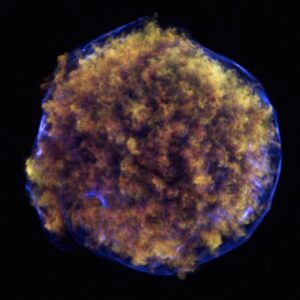
Shock waves occur when a material is enforced to move faster than the speed of sound in a medium. In astrophysical context, shock waves are very common, and are seen everywhere- in accretion disks, which accrete close to the speed of light, in relativistic jets, in stellar explosions such as the supernovae remnant seen above (the Tycho supernova remnant), in the solar corona, and many more.
One key difference between shock waves seen on earth (e.g., due to an airplane traveling faster than the speed of sound) and in astrophysical content, is the environmental density, which affects the shock formation and its structure. While on earth, the shock waves are mediated interactions between the air molecules, in outer space the density is so low that molecules do not interact directly; they do interact indirectly, though, via collective plasma effects. Since the temperature in astrophysics environment is very high, the atoms are ionixed, namely charged. Motion of charged particles is an electric current, which, in turn, generates magnetic field, which then affect the motion of other charged particles.
These collective plasma effects imply that the structure and properties of the formed collisionless shocks are different than their collisional counterpart. A basic question is therefore how these two types of shocks related to each other.
We have studied these in several papers, using both analytical and numerical approaches.
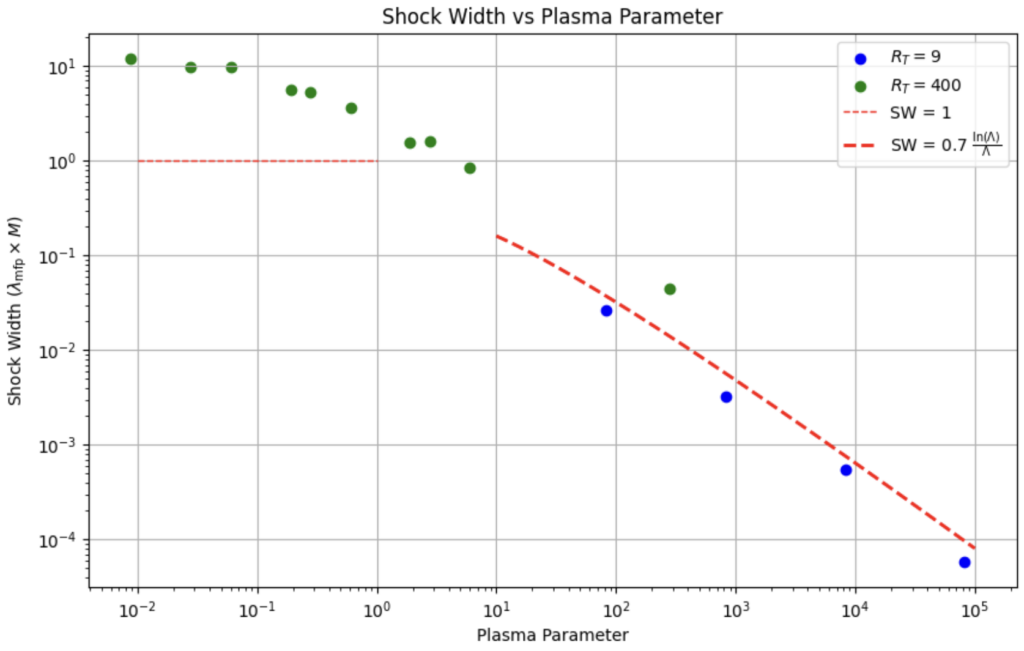
The figure above shows the results of a work led by my student Yossefl Kindi, where we investigate the width of shock waves, as they transit from collisional to collisionless regimes.
Origin of high energy cosmic rays
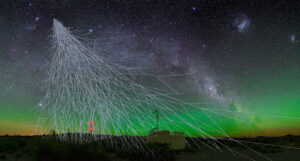
The physics of Fast radio bursts
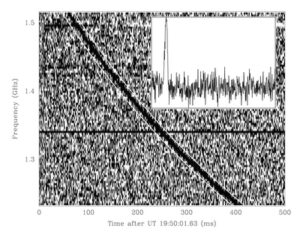
In 2007, a bright, quick (ms) radio pulse was detected, and disappeared. Dispersion measure, namely change in frequency due to light propagating inside the inter-galactic medium, proved that its origin is extra-galactic. As such, it need to be extremely bright.
It is now believed that this bright radio pulse is associated with a magnetar -a rapidly rotating, highly magnetized neutron star. However, such a right emission cannot have a thermal origin. While the exact mechanism that leads to this bright, coherent emission is of yet uncertain, leading candidate is a synchrotron maser emission.
Together with the Ph.D. candidate Killian Long, we investigated this model, and calculate the mechanism that leads to a population inversion that results from interaction of particles with relativistic Alfven waves. This calculation is essential in deducing the amount of energy that can be extracted in the form of synchrotron maser.
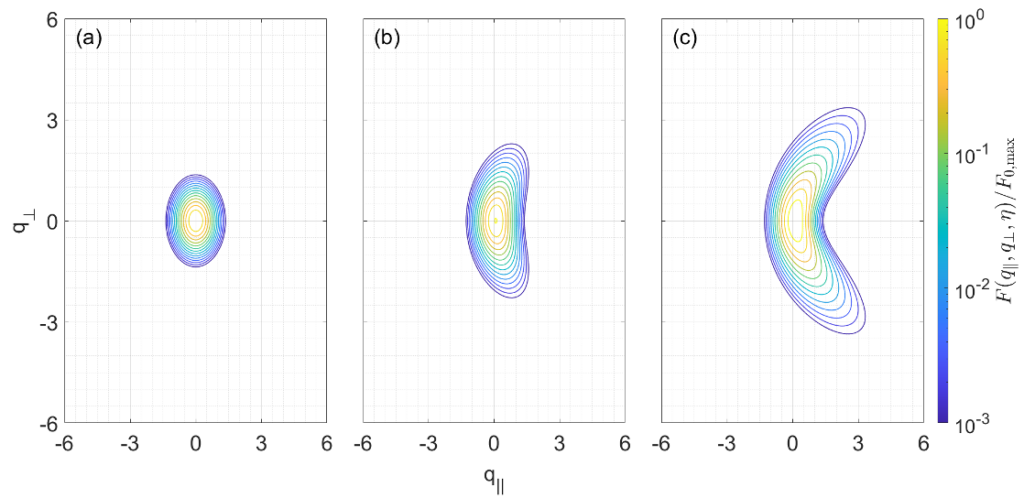
Here shown are the results of the calculation, showing the gradual formation of a population inversion, resulting from the interaction of Alfenic waves with relativistically hot electrons. The distribution (shown in momentum space) gradually develop a crescent shape, indicating a population inversion. Figure taken from Long & Pe’er.
Theory of photospheric emission from relativistically expanding plasma
 The center of the sun appears brighter than its edges (limbs). There is a physical reason for that: light coming from the center of the star originates from a deeper region, where the temperature is higher.
The center of the sun appears brighter than its edges (limbs). There is a physical reason for that: light coming from the center of the star originates from a deeper region, where the temperature is higher.
In many astronomical objects, such as gamma-ray bursts, there are firm evidence for a relativistically expanding outflow (jets). While naively one may expect a “Planck” function to emerge from the photosphere of these jets, I showed that due to relativistic aberation of light, the observed spectrum is in fact very different. I calculated this effect, which is the relativistic version of the known limb darkening effect.
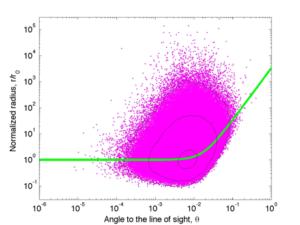
By definition, the photosphere is the inner most region from which an electromagnetic signal can reach the observer. In the inner parts of the outflow – of many astronomical objects, not necessarily GRBs (e.g., AGNs or XRBs), the density is so high that the optical depth exceeds unity; photons are trapped. As the outflow expands, the density decreases, and photons can eventually escape. In 3-dimensional (e.g., spherical) expansion, the optical depth is a strong function of the angle to the line of sight. I showed in my 2008 paper that in fact, for angles θ > 1/Γ, the photospheric radius is r_{ph} ∝ θ^2.
However, this is only part of the story; the photospheric radius is, by definition, the surface in space which fullfills the following condition: the optical depth for a photon that is emitted (or last scattered) from a point on this surface to reach the observer, equals exactly 1. However, photons have finite probability of being emitted (or scattered) in every point in space which is not empty. Thus, the definition of the photosphere as the place where photons last scatter, leads to the concept of “vague photosphere” (in the figure to the left, every point in r-θ plane represent the last scattering location of a photon emerging from spherical, relativistically expanding plasma jet).
This concept of vague photosphere implies that the observed spectra is very different than the naively expected “Planck” spectrum, due to 2 effects: (1) Different photons arrive from differnt angles, hence are observed with different Doppler boosts; and (2) Photons decouple the plasma at a range of radii, hene they suffer diferent adiabatic losses before escaping. Over all, these two effects leads to a significant modification of the “Planck” spectra (see figure to the right), which is the relativistic version of the “limb darkening” effect.
This work was considerably extended by former student C. Lundman, to include non-spherical jets, as well as polarization signal, which is a natural outcome.
